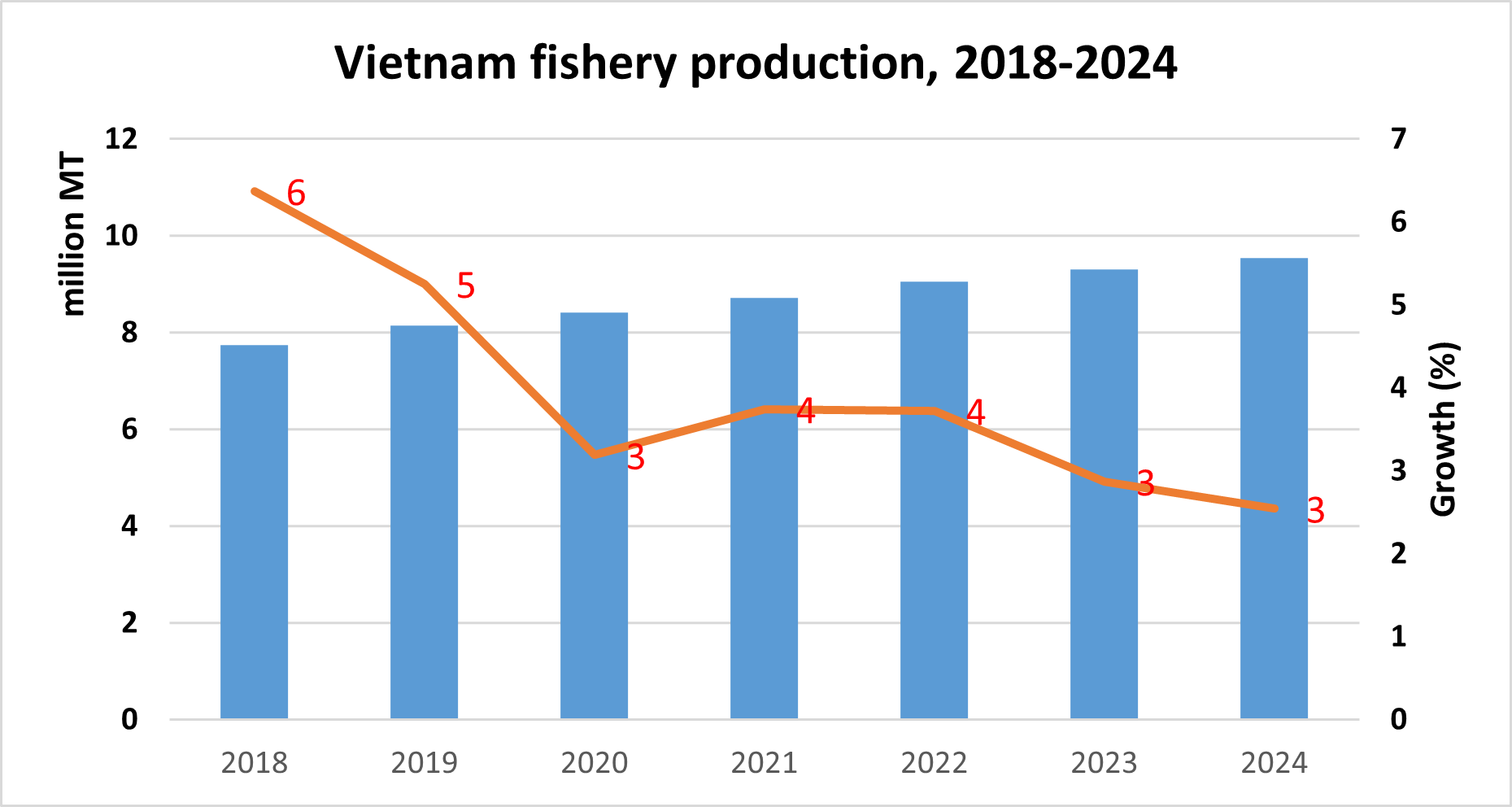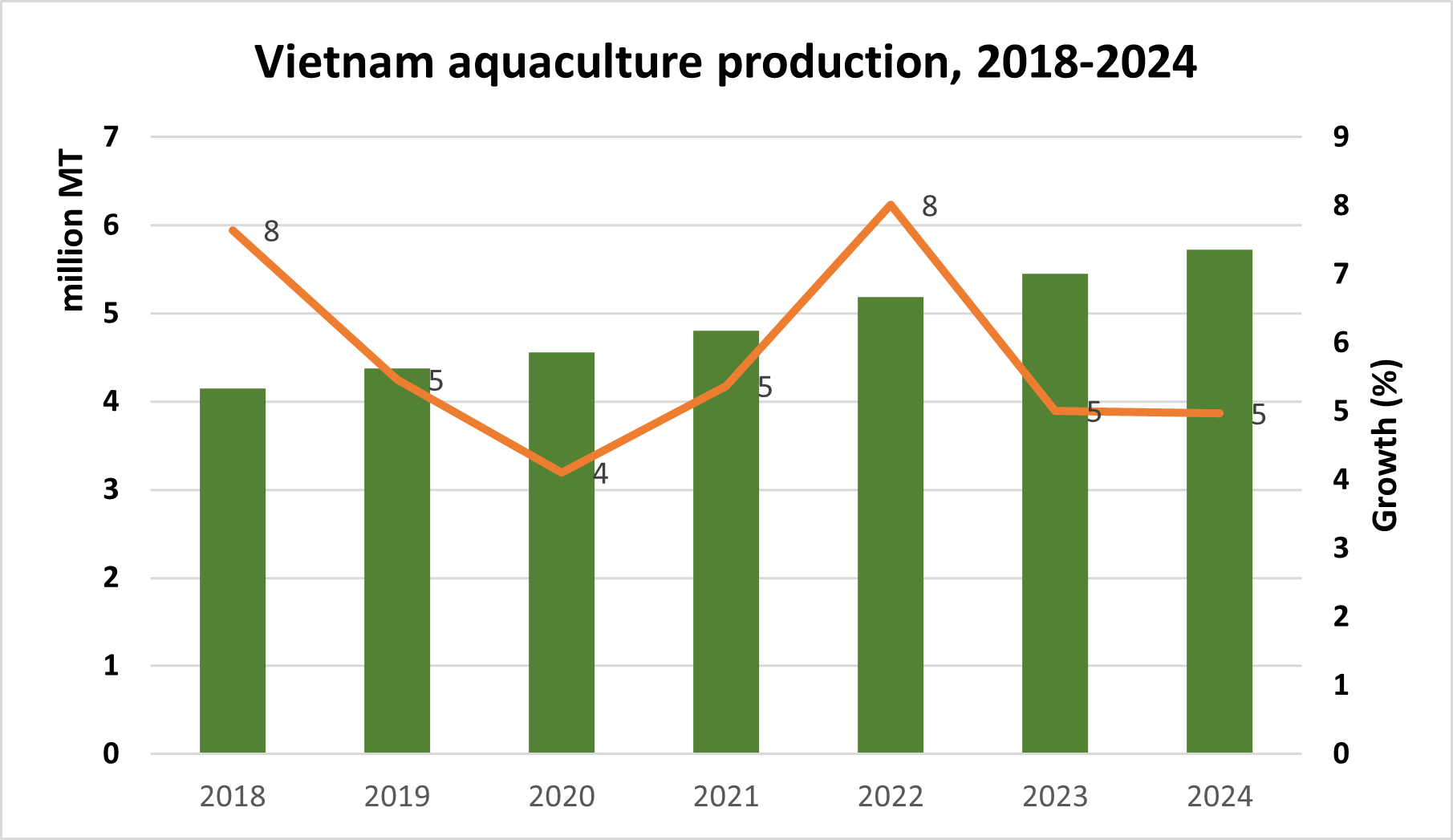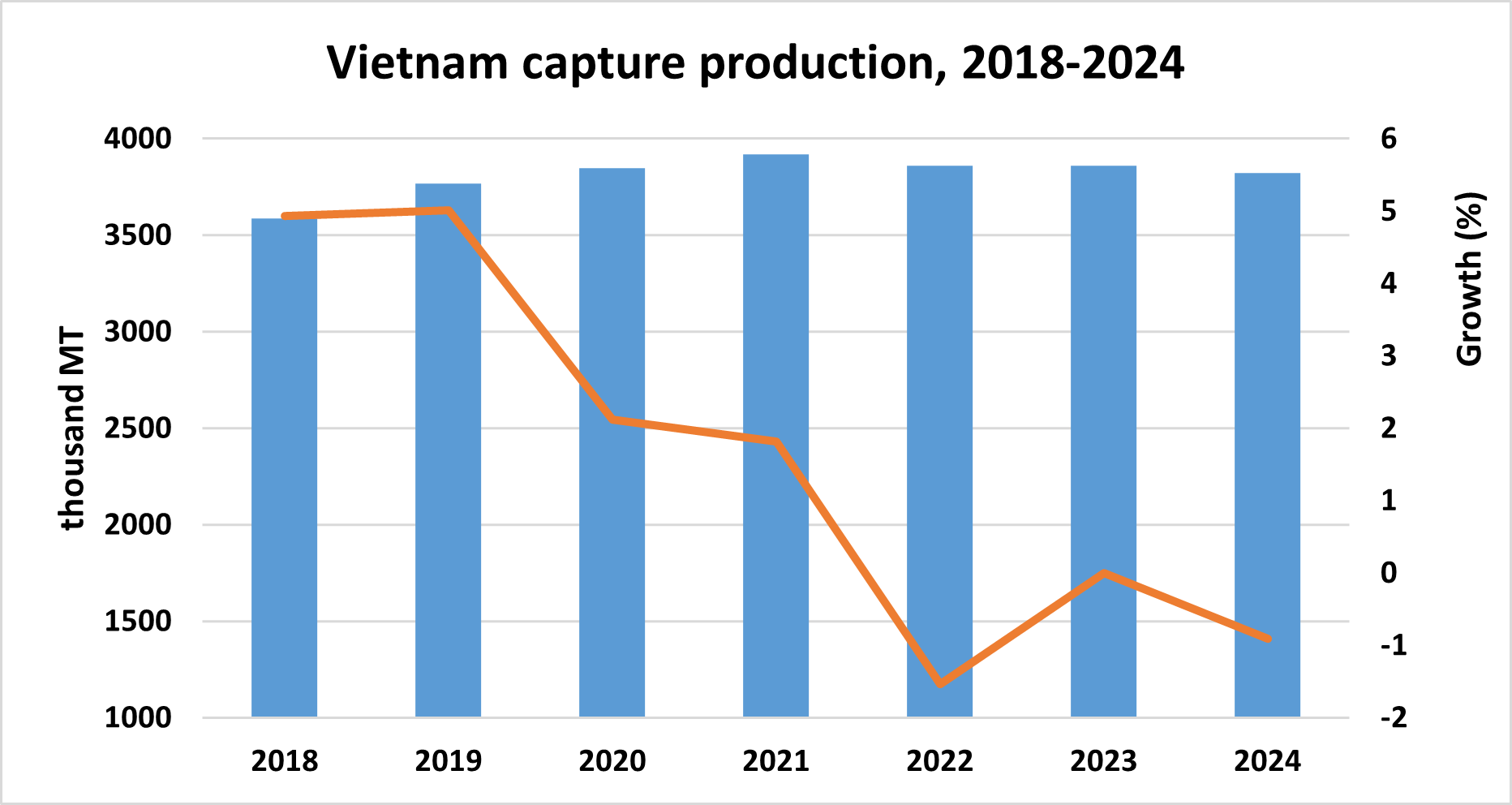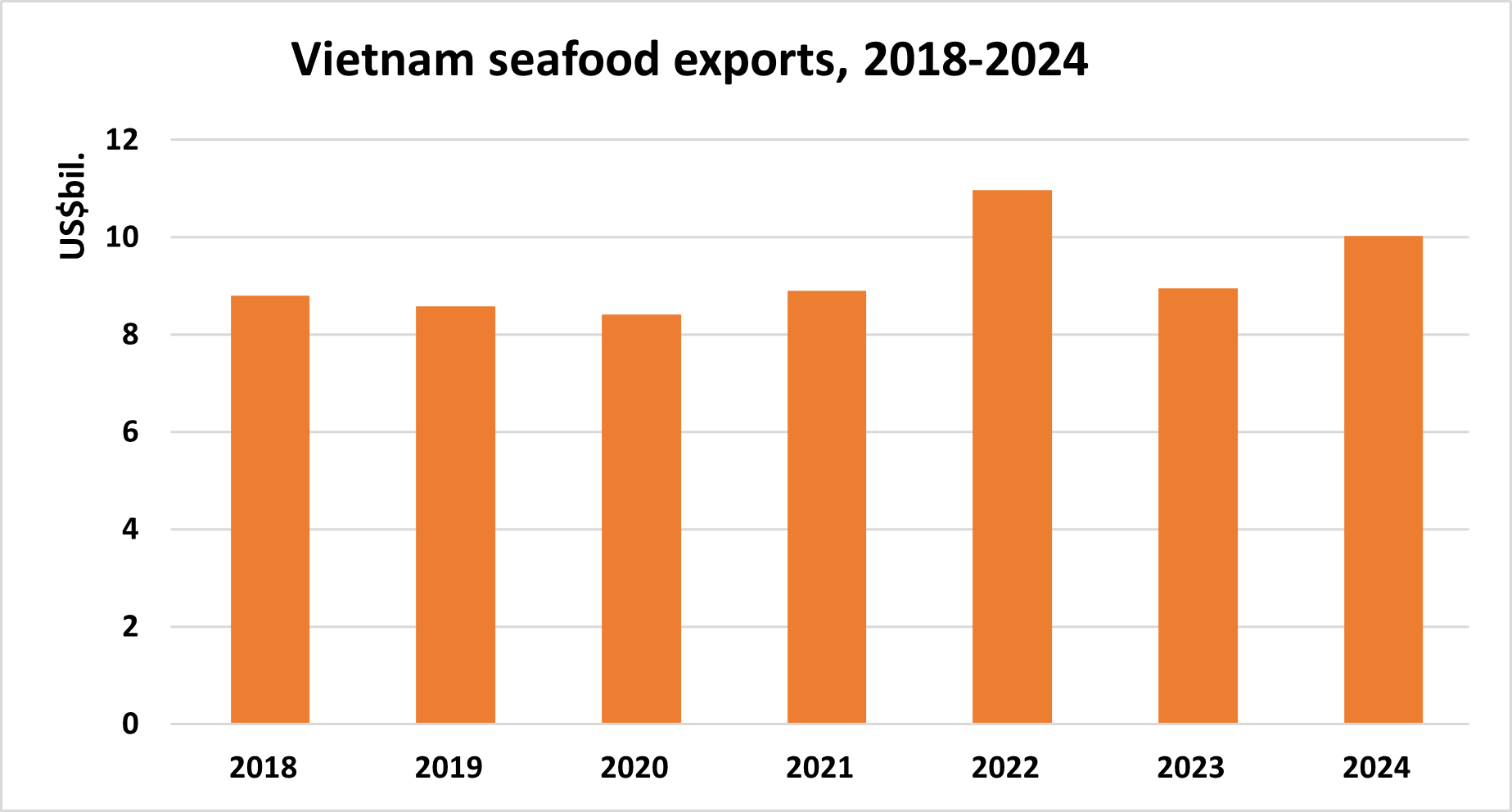I. OVERVIEW
Land area: 329,560 sq km
Coast line: 3,260 km
EEZ area: 1 million sq. km
Total fishery production in 2024: 9.5 million MT
Capture : 3.8 million MT
Aquaculture : 5.7 million MT
Export turnover in 2024: US$10 billion
Labour force: more than 4 millions
In particular, the processing and seafood export sector brings jobs to about 300,000 workers.
Fishery is a key national economic sector:
9-10% of total export turn over;
ranks 5th in export value from Vietnam behind telephone, textiles, electronics, and footwear.
contributes 4-5% of GDP;
One of the top 5 seafood export countries of the world with high export rate to the world's top markets such as the US, EU, Japan
II. PRODUCTION
From 2018 - 2024: Vietnam's seafood output increased from 7.7 million tons in 2018 to 9.5 million tons in 2024, an increase of 23%. Of which, aquaculture output accounted for 58%, fishing output accounted for 42%.

1. Aquaculture
From 2018-2024: Vietnam's aquaculture output increased from 4.1 million tons to 5.7 million tons, an increase of 38%. Aquaculture for exports is concentrated mainly in the Mekong Delta (accounting for 95% of total pangasius production and 80% of shrimp production).

Main aquaculture species in Vietnam
In 2024, total aquaculture area: 1.3 million hectares for inland farming and 9.7 million m³ of marine cages (equal to 2023). Total output: 5,753 million tons, up 4%, of which:
(1) Marine farming: 9.7 million m³ of cages, an increase of 2.1% (including: 4.5 million m³ of marine fish cages; 5.2 million m³ of lobster cages) and 58 thousand hectares of mollusk farming.
Total output was 832 thousand tons, an increase of 5% over 2023, of which: Sea fish 48 thousand tons; lobster 4 thousand tons; molluscs 460 thousand tons; other species 320 thousand tons.
Total area: 920 thousand hectares; Output: 1,724 million tons, including:
2) Brackish water farming:
- Shrimp: Farming area is 737 thousand hectares (black tiger shrimp is 622 thousand hectares, Whiteleg shrimp 115 thousand hectares); Output is 1.264 million tons, of which 284 thousand tons of black tiger shrimp and 980 thousand tons of white shrimp.
- Other species: 183 thousand hectares; 410 thousand tons.
(3) Freshwater farming: Total area of 380 thousand hectares; Total output is about 3,197 million tons, including:
- Pangasius: Area 5,700 hectares; Output 1.787 million tons
- Tilapia: 30 thousand hectares, 300 thousand tons
- Other species: 344 thousand hectares; 1.11 million tons.
2. Fishing production
From 2018 to 2024: Vietnam's fishing output increased from 3.59 million tons to 3.82 million tons, an increase of 7%.
Fishing output was stable in recent years, reaching 3.82 million tons in 2024. Vietnam has 28 coastal provinces. Big fishing provinces are concentrating in Central and South of Vietnam.

III. EXPORTS
From 2018-2024: Exports increase from 8.80 billion USD in 2018 to 10 billion USD in 2024. Vietnam's seafood export increased continuously in past years.

IV. VIETNAM SEAFOOD POTENTIALS
1. High commitment and participation from Government, Industry and companies for: Food safety, environment & social responsibility. All processing plants apply HACCP, increasing number of farming areas and processing got sustainable certifications such as ASC, GLOBAL GAP, MSC,VietGAP…
2. More and more attention from Gov , MARD, D-Fish and related state agencies to develop the industry with high and ambitious targets. (Decision No. 1445/QD-TTg of August 16, 2013, approving the master plan on fisheries development through 2020 with a vision toward 2030 )
3. Able to supply the big volume and safe, stable quality seafood products thanks to abundant resource (long coastal line, water and farming land area) + big number of seafood companies (600 exporters)
4. All processors and exporters are private, so they can proactively invest in the seafood sector.
5. Higher processing technology can create more processed products with high value.
6. Meet all the customers’ requirements, incl. the vertical linkage (intergration) for each sub- sector.
7. It was 1 of 3 countries in the World which has the good and stable labor resource.
8. Has Agreements / FTAs with many countries and territories è advantages both in product quality and im-ex tax. Up to March 2019, Vietnam has participated in 17 Free Trade Agreements (FTAs), whose countries occupy 90% VN seafood exports, of which 14 FTAs are signed and effective, accounting for 87% of VN seafood exports
V. VIETNAM FISHERIES DEVELOPMENT STRATEGY TO 2030, WITH A VISION TO 2045
On March 11, 2021, the Prime Minister issued PM Decision 339/ QĐ-TTg approving the Vietnam Fisheries Development Strategy to 2030, with a vision to 2045.
Specifically, by 2030, the goals of the fisheries sector include: Growth rate of production value of aquatic products reaching 3.0-4.0%/year; Total domestic seafood production of 9.8 million tons; The seafood export turnover reaching USD 14-16 billion; Creating jobs for over 3.5 million workers, with per capita income of aquatic workers equivalent to the average income of workers nationwide.
In addition, the Government aims to develop seafood processing and trade:
- Developing the seafood processing industry to become a large-scale commodity, playing a key role in leading and promoting the development of seafood production chains in the direction of increasing value-added production and sustainable development; soon turning Vietnam into a global seafood processing center.
- Forming enterprises and corporations as big as giants in the world, producing branded and highly competitive products in the world market.
- Actively integrating internationally, attracting investment, resources and expanding export markets, improving the quality and diversifying processed products for the domestic market.
- Maintaining and developing the market share of Vietnamese seafood in key markets, constantly expanding market share in potential markets ...
- Organizing the circulating production of aquatic products according to the product value chain ...